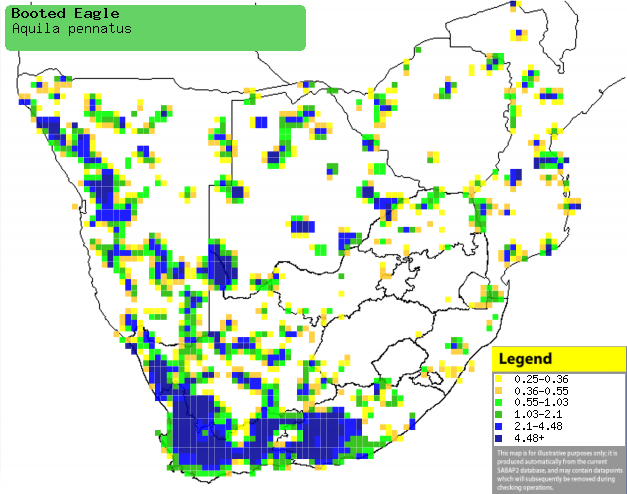|
Aquila pennatus (Booted
eagle)
[= Hieraaetus pennatus]
Dwergarend [Afrikaans]; Ekangakodi (also applied to some of
the other eagles) [Kwangali]; Dwergarend [Dutch]; Aigle botté [French];
Zwergadler [German]; Águia-calçada [Portuguese]
Life
> Eukaryotes >
Opisthokonta
> Metazoa (animals) >
Bilateria >
Deuterostomia > Chordata >
Craniata > Vertebrata (vertebrates) > Gnathostomata (jawed
vertebrates) > Teleostomi (teleost fish) > Osteichthyes (bony fish) > Class:
Sarcopterygii (lobe-finned
fish) > Stegocephalia (terrestrial
vertebrates) > Tetrapoda
(four-legged vertebrates) > Reptiliomorpha > Amniota >
Reptilia (reptiles) >
Romeriida > Diapsida > Archosauromorpha > Archosauria >
Dinosauria
(dinosaurs) > Saurischia > Theropoda (bipedal predatory dinosaurs) >
Coelurosauria > Maniraptora > Aves
(birds) > Order: Falconiformes
> Family: Accipitridae
> Genus: Aquila
Distribution and habitat
It breeds from central Asia to southern Europe and
North Africa, heading south in the non-breeding season to India and
sub-Saharan Africa. In southern Africa it
is locally fairly common in patches across the region; it also has a small
breeding population in the Western and Eastern Cape. It generally prefers
mountainous country with cliffs, although non-breeding migrants can occur in
almost any type of natural habitat.
|
 |
|
Distribution of Booted eagle in southern Africa,
based on statistical smoothing of the records from first SA Bird Atlas
Project (©
Animal Demography unit, University of
Cape Town; smoothing by Birgit Erni and Francesca Little). Colours range
from dark blue (most common) through to yellow (least common).
See here for the latest distribution
from the SABAP2. |
Movements and migrations
Complex, as it has two different populations
which occur in Africa, each with a different migratory pattern. The
one breeds in Eurasia then heads south to southern
Africa, excluding the Western Cape and Namibia, where it stays from
November-February. The other population breeds in the Western and
Eastern Cape, arriving from July-August and staying until March, it
spends the rest of its time in its non-breeding grounds in Namibia and
southern Angola.
Food
It mainly eats birds, usually hunting aerially, stooping
from a position high above the ground, to surprise and strike
its prey from above. It sometimes fails to pull up from it's dive in time, then
hits the ground with a thump. The following food items have been recorded
in its diet:
Breeding
- Monogamous, territorial solitary nester, performing spectacular aerial
displays in which it calls loudly, while performing steep dives and upward
stoops.
- The nest is built or refurbished by both sexes, consisting of a platform
of thin sticks and twigs, with a cup lined with green leaves. It is typically
placed at the base of a bush or small tree on a cliff ledge, often using the
same nest repeatedly for up to about 28 years. It may also rarely breed in
the canopy of a Eucalyptus tree in an open are, or alternatively use
the old
nest of a Grey Heron or
Black kite.
- Egg-laying season is from August-January, peaking from
September-October.
- It almost invariably lays a single egg, which is mainly incubated by the
female for about 44-46 days.
- The chick is fed by the female with food provided by the male, leaving
the nest after about 70-75 days.
Threats
Not threatened, although in some localities its population
is decreasing, due to habitat disturbance and poisoning.
References
-
Hockey PAR, Dean WRJ and Ryan PG 2005. Roberts
- Birds of southern Africa, VIIth ed. The Trustees of the John Voelcker
Bird Book Fund, Cape Town.
|
